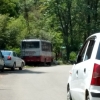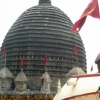What has Agra got to offer beyond Taj Mahal ?
We had planned a night halt in Agra while coming back from Jaipur by road. The plan was to reach Agra by around 1.00 pm and then visit Sikandara complex. Next day, post check out, visit either the tomb of I’timād-ud-Daulah (father of Noor Jehan) or Taj Mahal (why we dropped the idea of visiting the tomb of I’timād-ud-Daulah is a story in itself)
I had been to Sikandara complex as a child (6 or 7 year old, I still have those black and white photographs from my dad’s collection who is an internationally trained photographer), when the place was not managed the way it’s being managed now. The only memories I had of the complex was that there was a big gate to go inside and then there used to be a small pond like empty structure where the Langurs were playing. Beyond that I had no memories of Sikandara.
The Sikandara complex has changed, though the gate and the pond like structure were still there. Some parts have been restored and restoration work was going on some areas. The only thing which was missing was details about the complex. I hope the ASI takes care of it soon. Lack of official details forces people to rely on guides, and this necessity aides a lot many self-styled untrained guides. Sikandara also had a hoard full of such guides including many middle-aged ladies who probably are residents of locations nearby. You tell a lie a thousand times and it becomes the truth. This is what was happening there, for a small amount they were shelling out historically inaccurate stories probably heard from some other similar members.
While showing the graves in the Sikandara complex – these self-styled guides talked about Sikandara being the resting place of Akbar’s first wife (this is completely inaccurate) and that his Christian wife was buried some distance away in a tomb (the tomb of Mariam-uz-Zamani), his hindu wife aka Jodha Bai was cremated at Arjun Nagar and there is a Chattri (similar to Gaitor) in her memory (historical inaccuracy at its height).
Felt like killing these self-styled guides who were dishing out this historical nonsense. But more than them we have Mr. Ashutosh Gowarikar to blame for this – through his ill-researched movie Jodha Akbar he has strengthened this false belief of Akbar’s Hindu wife Jodha, how important she was and how much he loved her.
In fact, Indu Sundaresan’s ‘Taj Mahal Trilogy’ are far better researched and historically accurate books on this, a tele-series called ‘Siyasat’ based on her book, ‘The Twentieth Wife’, was telecast on Epic channel (and currently EPIC is doing its reruns).
I could see the impact of the crap supplied by the self-styled guides along with the information from ‘Siyasat’ on many tourists, especially a 15 member Bengali group where there were many middle-aged and elderly ladies. A middle-aged lady kept on explaining her group who Akbar’s first wife was (the Pasha (Padshah) begum – a term she had picked up from the serial) and how cruel she was and why her grave was not next to Akbar. Many lies, incorrect information – Lo and Behold, the truth had been created.
The fact is different. The Chattri in Arjun Nagar is said to be of Jodha; no, there was no Jodha Bai who was Akbar’s wife, this Jodha is Jehangir’s wife, princess of Jodhpur, her real name was Jagat Gosain and she was not cremated as per Hindu rites but she was buried here.
Akbar had 300 wives/consorts, whether there was someone of Christian origin in these 300 is another matter of research but among his important wives there was no Christian lady who would have got such a huge burial space. One fact that should hit tourists who are visiting Sikandara and listening to this crap is that a there will be no tomb which will be made for a Christian lady – she would be buried in a Christian graveyard, where her grave might have an elaborate gravestone.
Coming back to this mysterious tomb.
This tomb is around a kilometer away from the main Sikandara complex. Its’ located on the other side of the road and not immediately visible from the main road, one has to take a left turn onto a small lane. Thankfully there is a clear signage about the tomb on the main road. Yes the tourism department wishes people to visit this but other than putting up clear signage, there is lot more which needs to be done to attract more tourists.
There was no proper parking area. We parked our vehicle as close as possible to the gate. There were a few two wheelers parked. The area looked quite unsafe. The tomb area is fenced with common metal fence. There was a wooden cabin which was serving as a ticket counter (yes, there is an entry ticket to this tomb, though the amount is minimal but I think this would help in some way to maintain the garden areas). There was a non uniformed person standing at the gate probably to check tickets. When we entered, he checked with me if I had a video camera with me, my still camera was anyway hanging in my neck (there is no sign in the area which says photography or videography not allowed). I cross questioned him that why was he asking the same to which he gave a standard answer – photography nahin allowed hai (photography not allowed). I retorted asking him to show me the prohibition note. His answer was, “jao jao shor mat machao (go, don’t make noise).” I was really annoyed – he had just allowed a couple to enter the complex without showing any tickets, probably he had got some money from them (this would have been a regular feature with him) and he had not asked them anything. I asked him why did he allow them and why didn’t he check with them, he was pretty sheepish and then smilingly asked my husband to go ahead, “Sir Main toh duty kar raha thaa, madam gussa ho gayin (I was doing my duty, madam got angry).”
We didn’t want to waste more time with him and thus moved ahead. Right next to the gate, there were two stone information slabs in Hindi and English, one on each side of the stone pathway. The square dome less tomb stands in the centre of a garden, where all efforts were being done to maintain the greenery.
This tomb is under ASI and some restoration work has been done. The information slabs clear the mystery – this tomb is of Mariam-uz-Zamani, Akbar’s wife who was the daughter of one Raja Bharmal. Yes, this is the tomb of Akbar’s famed Hindu wife, Rajput Princess, eldest daughter of Raja Bharmal of Amer. She was married to Akbar in 1562 and gave birth to Salim aka Jahangir in 1569. She was given the title Mariam-uz-Zamani (“Mary of the Age” – probably Akbar was in touch with the stories of Christianity at that point of time). She died in 1623 and Jahangir built this tomb for her (1623-1627). Her original name has not been mentioned on the information slab. Some historical sources of that time mention a name Heerak or Heer Kunwari, daughter of Raja Bharmal – so for all practical purposes Mariam-uz-Zamani is Heer Kunwari.
A point to be noticed here is that this tomb was not built from scratch. This tomb was originally an open baradari (pleasure pavilion) built during the reign of Sikandar Lodi in 1495 AD, which was adopted by the Mughals and converted into the tomb by making a crypt below the central compartment; reconstructing the four facades of the building with carved red stone panels and a chajja with addition of duchattis (mezzanine floors), the corners and remodeling the superstructure with Chattris and Chhaparkhats.
The chhatris and chhaparkhats are the important ornaments in the whole composition. The tomb doesn’t have a dome and thus this mausoleum is of architectural importance in the category of dome less tombs of the Mughal era. Another important aspect of the tomb is that unlike other Mughal era structures, the rear entrance is not a dummy entrance, it’s a real entrance; the tomb is identical on both sides – front and rear.
The tomb is built of brick and mortar. The ornamentation (as per the records there was a decent amount of ornamentation) is not much visible now. On the exterior in the red stone structure, we could see few floral designs and wines vases (regular design feature of the Mughal era) but nothing much. The inside was pretty bare. The tombstone on the ground floor is nothing but a flat marble stone (nothing like the elaborate tombstones of the Mughal era).
The mausoleum contains three tombstones: one in the underground mortuary chamber, which is the grave itself; the cenotaph above it on the ground floor; and another cenotaph on the terrace.
The whole complex had a dark dejected feel to it.
It was as if through her final resting place, the Hindu wife of Akbar was trying to tell the story of her life – a story of utter neglect and dejection, a story of loosing independence and dignity, a story of rejection by everyone including the two of the most important persons in her life – one to whom she was married to and the other whom she had given birth. The idea behind Sikandara was that Akbar wanted everyone of his immediate family members to be buried alongside him, but this wish was only partially fulfilled – his most important wife Ruqaiya Sultan Begum was buried in Garden of Babur in Kabul, as per her wishes (yes she is the same Padshah begum of that Bengali lady, Akbar’s first wife and she is not there in Sikandara as is proclaimed by the self-styled guides), the other wife of importance Salima Sultan Begum was buried in Mandarkar Garden, Agra as per her wishes. And the Hindu wife who is wrongly popularised as the most loved one is buried a kilometre away in a corner, in a tomb which was not even constructed for her from scratch, a pleasure pavilion from the past, of a different dynasty was remodeled for her.
The tomb today is frequented by druggists and couples who want a cheap option to satiate their carnal desires. I am being too decent when describing them. These couples use the dark corners right next to the tomb area (with no regards for the dead) to tease the lady who is resting there – to show what she is missing now. These bold couples are ready to fight with tourists for their open bed spaces. We saw quite a few of them, the non-uniformed person and probably many others provide them with complete security for a measly sum. The only people in the complex who were getting irritated with them were the gardeners who kept on requesting them not to walk on grass – a plea which was falling on deaf ears – so much so that a girl even shouted back saying I want to lie down in the middle of the garden, so I would walk on the grass. The activities of the couples along with the presence of the druggists is a deadly combination and a big unwanted incidence is just waiting to happen.
The eerie and uncomfortable feeling which we had was increased by the disregard by such people towards areas of national importance. We left the place with our heart filled with sadness.
The ASI and tourism department should focus on promoting these secluded areas also – there are lot many things in Agra beyond Taj Mahal, architecturally and historically important. Tour promoters should also focus on these areas. This would reduce the activities which we mentioned earlier.



Comments